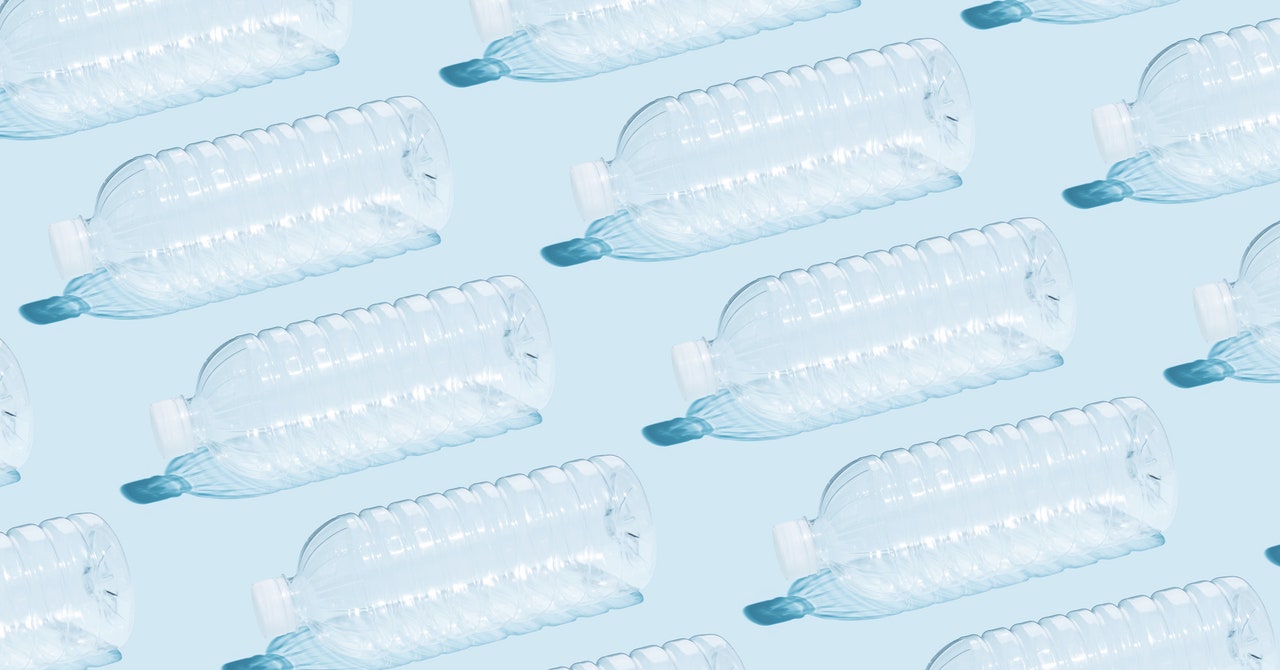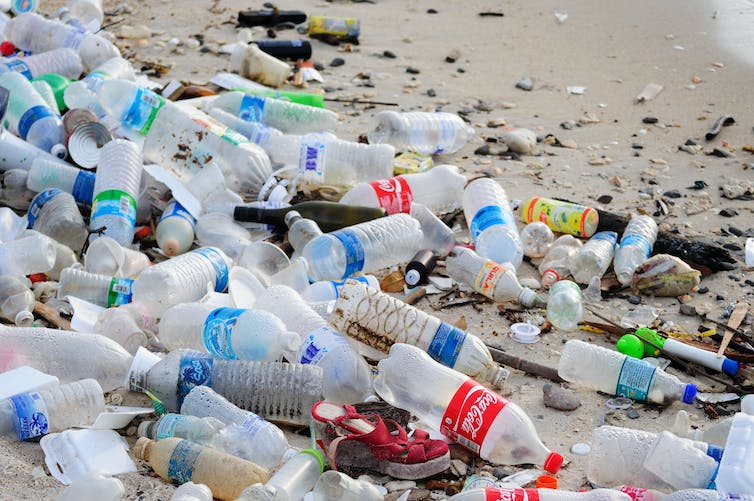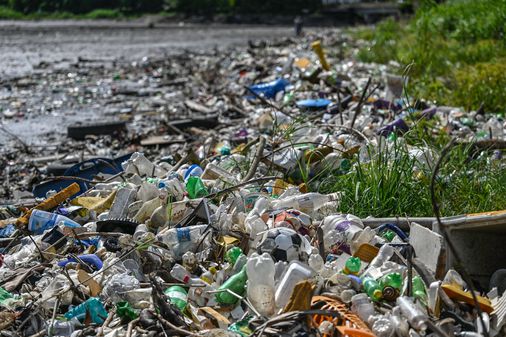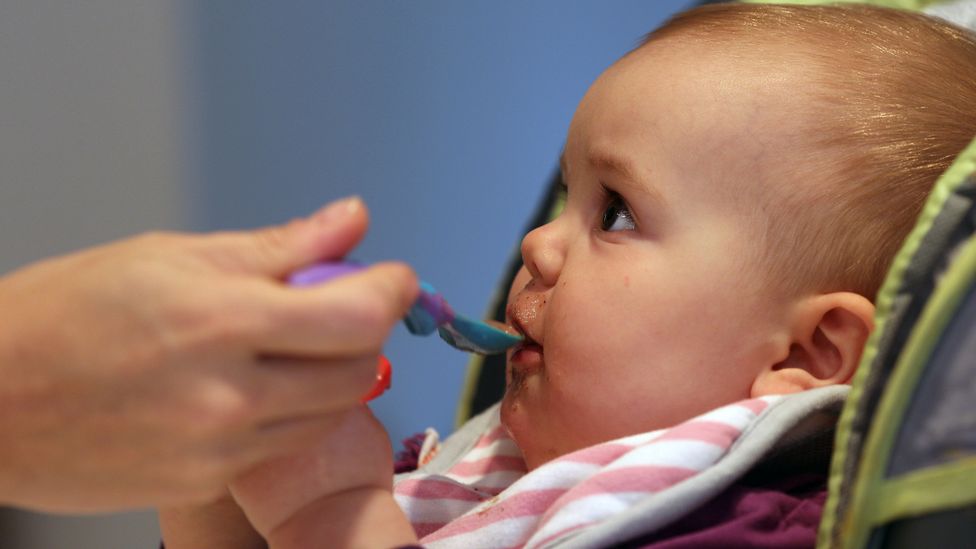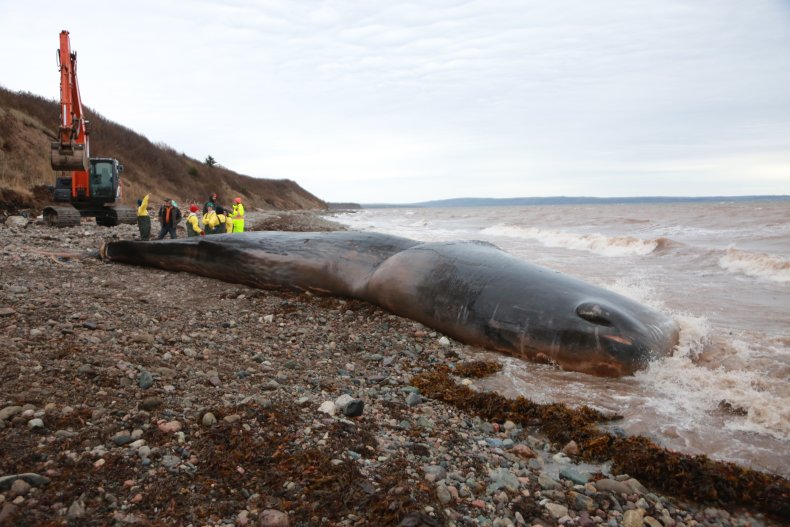Reusable nappies and zero-plastic baby food: is sustainable parenting doable?I am preparing to embark on a challenge to parent more sustainably, and, as I stand in my kitchen to get a feel for where I might be able to make some changes, I can’t help but feel I’ve bitten off more than I can chew. Plastic baby bottles are lined up like skittles in my cupboards; drawers are a technicolour spectacle of lurid plastic baby food pouches and individually wrapped biscuits. Tupperware and zip-lock plastic bags threaten to consume me, and there are plastic bowls, weaning pots, and baby spoons everywhere.
“Is having a baby in 2021 pure environmental vandalism?” reads one headline I come across in my research. Looking at my kitchen, I can see why.
Since my daughter was born almost two years ago, I have sleep-walked into making what I can only describe as baffling consumer choices that stamp on any eco credentials I previously claimed. Between the sleep deprivation and the onslaught of new experiences and mixed emotions, I have accumulated so much stuff – and much of it made from single-use or non-recyclable materials. Apparently I’m not alone. Sustainability “goes out the window” after having a baby, according to a One Poll survey commissioned by Baby Dove, and more than a quarter of new parents said it was “impossible” to be more eco-friendly with a newborn.
As an experiment, I want to see if I can make some greener swaps in a bid to understand what the barriers are to parenting more sustainably, and what else the industry needs to do to clean up its act. I found there were plenty of areas where I could make small changes, from shopping more sustainably to choosing different products. But I was also struck by how limited I was as a consumer to make any meaningful impact, and how unscientific many of the claims around “sustainable” or “biodegradable” products are.
Jen Gale, author of The Sustainable(ish) Guide to Green Parenting, elaborates on this when I ask her why it is so hard for new parents to make green choices. “Parents are marketed at quite hard by those brands with the most money, which might not necessarily be the most ethical and sustainable companies,” she says. I think back to the antenatal pack I was handed by a midwife at my 20-week appointment, full of big brand products in plastic packaging. Then there is the lack of time, energy and headspace to research greener alternatives, she says. “Shopping sustainably might not be at the forefront of your mind – especially when you’re just trying to get through the day, you grab whatever you can and whatever is the most convenient.”New parents often don’t have the time or energy to research greener alternatives (Credit: Tim Clayton / Getty Images)Increasingly, global consciousness is turning to the problem of plastic pollution, with the annual flow of plastic into the ocean alone estimated to nearly triple by 2040 to 29 million tonnes per year. But despite widespread initiatives to curb the use of plastic straws, single use plastic bags, and plastic bottles, unsustainable materials and methods seem to be ubiquitous in the products we buy for our children – from bottles, which shed millions of particles of microplastics, to disposable wipes and nappies that never biodegrade.
The toy industry is the most plastic intensive industry in the world, according to the United Nations Environment Programme – with millions sent to landfill each year having barely been used. Even formula use has an enormous environmental impact, which is rarely examined. Most formulas are made from powdered cows’ milk, needing an astonishing 4,700 litres (1034 gallons) of water to produce just 1kg (35oz) of powder. In fact, 1kg of infant formula releases between 11 and 14 kg (388 and 494oz) of greenhouse gases by the time it is fed to babies and young children.
As part of my desire to clean up some of my parenting choices, I want to look at my baby’s nappy consumption. We throw away about three billion nappies each year in the UK, representing an estimated 2% to 3% of all household waste – one of the biggest contributors to plastic waste globally. Globally, more than 300,000 nappies are disposed of every minute. In the US, the scale of the problem is magnified, and the industry that feeds it is valued at $71bn (£61bn). Most nappies are made from two non-biodegradable materials – a polyethylene waterproof back layer and a polypropylene inner layer – meaning that when they ultimately end up in landfill, they will likely remain there for 500 years or more.
Reusable nappies are often touted as the sustainable fix – so I ask a friend who has used washable nappies for her children if she can lend me some to try. I’m slightly dreading starting the experiment – I have visions of nappies hanging to dry from every high surface in our small flat. I’m bracing myself for the upfront financial shock – a starter bundle can cost upwards of £100 ($115) or more, which can make the idea of using reusables daunting, or entirely inaccessible for some people. I’m also wondering how much my energy bill will rise this winter if I’m increasing my use of both the washing machine and its dryer setting. But I’m hopeful that this might be easier than I’m imagining, and could become a permanent green swap that will help me lower my carbon footprint.
“There are lots of ways of lowering the cost of making greener choices,” says Gale, though the options can vary hugely depending on where you live. Various social media sites and second-hand marketplaces offer second-hand reusable nappies, and in the UK, so-called nappy libraries let parents borrow nappies and try different brands. I take a bundle from my friend, and buy a pack of biodegradable bamboo nappy liners for £2.50 ($2.87). I also buy a dry pail – essentially a plastic bucket with a tight lid to store the soiled nappies before washing – for £15 ($17.19).
You might also like:
Living without plastic in Japan
The most sustainable way to eat fish
What if we had limitless green energy?
I’m glad I go down the second-hand route, because not only is it more sustainable but it’s also more affordable. And I’m grateful for this cost saving when my careful plan falters at the first hurdle. My daughter seems to hate the feel of the reusable nappies on her skin, which can feel wetter than the moisture-wicking disposable alternatives she is used to. They are also much bulkier than single-use nappies, and the extra material causes her clothes to pull in the crotch, giving her a cowboy kid gait. At this stage of toddlerhood, getting her to switch from the disposable nappies she has been wearing since birth, to an altogether bulkier, and wetter feeling fabric is possibly too big an ask, and I can’t help but feel we have missed the boat.
But what does the science say – would it have been a greener choice? One Environment Agency study in 2008 found that reusable nappies can have a 40% lower global warming impact than disposable nappies. But crucially, the positive impact of switching to reusable nappies depends on how eco-conscious the consumer is. Many people looking to reduce their environmental impact wash at low temperatures, but reusable nappies must be washed at 60C (140F) in order to kill bacteria, and machines should not be overfilled, according to the Nappy Alliance, a coalition of reusable nappy providers. A study by the Life Cycle Initiative, a project launched in partnership with the UN Environment Programme, found that washing reusables over 60C (140F), using a tumble dryer, or partially filling the machine can actually negate their positive environmental impact entirely, and could make it preferable to use single-use nappies from a climate change stand point.
The study highlights the importance of looking at the entire life cycle of any product in order to weigh up how eco-friendly it is. “The highest impacts of reusable nappies occur not in manufacturing but in the use phase, while for single-use nappies, the design of the nappy (the weight and its materials) along with its management at end-of-life are the important life cycle stages,” write authors Philippa Notten, Alexandra Gower and Yvonne Lewis.From bottles, which shed millions of microplastics, to disposable wipes and nappies, unsustainable materials are ubiquitous in the products we buy for our children (Credit: Alamy)So what about biodegradable options? A stroll around my local Boots points to a small but growing raft of eco nappy brands made from recycled materials and sustainably-grown renewables, such as bamboo and organic cotton. Could buying disposable nappies made from more eco-conscious materials be a simple way for parents to make a difference?
Charlotte Lloyd, an environmental biogeochemist from the University of Bristol, is sceptical. When it comes to reducing your individual environmental impact, these nappies “are completely ineffective”, says Lloyd. None of the eco nappies on the market are currently 100% biodegradable (nor do they claim to be). Even those with high percentages of biodegradable materials need the right conditions for the materials to biodegrade, often involving industrial hot composting facilities that are nowhere near widespread enough to be a mass market solution. The vast majority of “eco” nappies end up in landfill, just like regular nappies. Landfill conditions are specifically designed to prevent decomposition due to the harmful gases and liquids that can leach out into the earth during the biodegradation process.
“I applaud the companies for making them, they are trying to make a better product,” says Lloyd. “But the rest of the system needs to catch up.” Despite focusing much of her research interests on the impact of plastic degradation on the environment, Lloyd has used disposable nappies with her two children. “I’m slightly ashamed of it but I just couldn’t deal with the washing, using reusables, and I’m sure that’s the same for a whole raft of parents and that’s why they go to the biodegradable alternatives, which are more expensive, and no more beneficial.”SUSTAINABILITY ON A SHOESTRINGWe currently live in an unsustainable world. While the biggest gains in the fight to curb climate change will come from the decisions made by governments and industries, we can all play our part. In Sustainability on a Shoestring, BBC Future explores how each of us can contribute as individuals to reducing carbon emissions by living more sustainably, without breaking the bank.So what needs to be done? There is currently only one nappy recycling company in operation in the UK: Nappicycle, based in Wales. The company runs a recycling facility which specifically treats nappy and absorbent hygiene products and aims to recover 100% of the cellulose and plastics to be used elsewhere.
This year, the company was involved in laying the “first nappy road” – a trial in which a stretch of the road between Aberystwyth and Cardigan in Ceredigion has been replaced with asphalt reinforced with recycled nappy fibres.
It’s clear that more initiatives like Nappicycle are paramount to tackling the UK’s nappy waste problem. In order to reduce the environmental impact of nappies in the UK, we need to urgently improve our existing waste management systems, says Lloyd. “You’re never going to get a situation where everyone is going to wash nappies – it’s never going to happen.”I want to see where else I can make greener choices for my daughter. Back in my kitchen, I have a stock of plastic packets of rice, pouches of porridge and toddler snacks, which I would like to try and swap for greener alternatives. In the UK, the baby food sector is booming, growing by 30% between 2009 and 2014 – when it was estimated as an £181m ($207m) industry per annum. China is currently the biggest market for baby food as of 2019, with India coming in second place, and the United States ranked in sixth place. And it’s not hard to understand why the industry has such global popularity.
The industry responds to a desperate need for convenience for time-poor, working parents. But despite the sector’s growing popularity, little is known about the sustainability of the industry. In the lentil and vegetable bake I dig out for dinner, for example, organic broccoli, parsnip and green lentils are listed as the main ingredients. In the UK, the organic label means at least 95% of the product’s agricultural ingredients are organic, and have strict regulations about the use of pesticides. But apart from that, I know nothing about the environmental impact of these prepared foods – from where they were grown, to how they were cooked (Read more: Why some climate claims are unprovable).Washing reusable nappies at 60C and putting them in the tumble dryer can negate their positive environmental impact (Credit: Ulf Swane / Getty Images)So far, my attention has been focused on the proliferation of plastic packaging involved in the baby food industry. But Ximina Schmidt, a life cycle sustainability expert at Brunel University in London, with a special interest in sustainable food systems, urges me to consider “all the different contributing elements” involved in making a food product in a bid to reduce my environmental impact. Baby food meals with more meat and cream have a higher environmental impact regardless of packaging, according to one study, which Schmidt co-authored. From the farming processes, ingredients and packaging materials, to the energy needed to manufacture that food and cook it, the more stages of the production process we are able to avoid, the “greener” a product will be, Schmidt says.
With Schmidt’s advice in mind, I decide to try baking some biscuits for my daughter at home, rather than buying them from the supermarket. I choose a simple recipe calling for apples, flour and butter, which I substitute with vegan butter. The ingredients cost me roughly £3 ($3.44). I am planning on baking 24 biscuits, and buying a similar quantity would have set me back £4.50 ($5.16). So far, the cost seems to be favourable (if I don’t count my labour). But we’re not out of the woods yet. Schmidt tells me to be mindful of the cooking method – am I going to put the oven on for a single tray of biscuits? If so, my energy expenditure would almost certainly negate any positive impact of baking the biscuits myself, both environmentally and financially.
According to the Energy Saving Trust, to heat small amounts of food, the humble microwave is the most energy efficient option. But to offset my use of the more expensive oven, I make sure to bake my biscuits while the dinner is also cooking, and they come out looking edible, with no objections from my daughter. The next hurdle is storing them. How can I prolong their shelf life to avoid waste? I store 12 in an airtight tupperware, and put 12 in the freezer, wrapped in foil – the freezer’s own environmental impact somewhat offset by it already being in use for other food.How can you be a more sustainable parent?
Buy second-hand toys, clothes and books
Buy local and cook at home
Wash at 30C (except nappies and soiled clothes)
Give unused toys a new lease of life – donate to a baby bank
Swap beef and dairy for sustainable proteins, such as lentils
Sign up to Whirli, a toy swap subscription
Overall, this seems like an easy swap, although requires some advance planning which could be difficult for time poor working parents. But is this a greener solution?
There are definite positives for transparency – I have a better understanding of the product life cycle of these biscuits than bought ones. But factoring in my energy consumption, it is hard to say definitively whether baking them at home is significantly greener. Part of the barrier to reaching a conclusion is the lack of visibility afforded to the average consumer. There is very little information available about factory cooking methods or product sourcing, so it is almost impossible to analyse a product’s carbon footprint with the information provided on the packet.
It’s also important to highlight how gendered the responsibility for making greener choices at home can be. Most women perform far more cognitive and emotional labour than men. As a time poor, working mother, the mental labour required to rethink tried and tested products in favour of greener alternatives is not insignificant, and should be factored into the barriers facing parents wanting to parent more sustainably.
So what have I learned from my experiment? In a fog of sleep deprivation and learning how to operate as a family of three, it has been frighteningly easy to get into bad habits as a new parent. The main takeaway from both of my swaps is the need to evaluate my consumer choices through a life cycle lens, rather than simply eschewing certain materials. For me, the experiment has encouraged me to revisit the basics – the adage “reduce, reuse, recycle” should remain the mantra to live by.
Gale reassures me that green living need not be complicated: one of the most sustainable things parents can do is buy second-hand. “There’s a pressure as a new parent to buy all these wonderful, shiny new things – and especially with your first you want that,” she says. “You want everything to be pristine and new because they’re so precious and vulnerable.” Ultimately, I’m reminded that this is my daughter’s world, and the choices I make on her behalf will impact her future in a much more significant way than they do mine.
—
Join one million Future fans by liking us on Facebook, or follow us on Twitter or Instagram.
If you liked this story, sign up for the weekly bbc.com features newsletter, called “The Essential List” – a handpicked selection of stories from BBC Future, Culture, Worklife, Travel and Reel delivered to your inbox every Friday.



